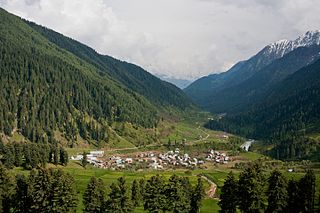
Taï National Park is a national park in Côte d'Ivoire that contains one of the last areas of primary rainforest in West Africa. It was inscribed as a World Heritage Site in 1982 due to the diversity of its flora and fauna. Five mammal species of the Taï National Park are on the Red List of Threatened Species: pygmy hippopotamus, olive colobus monkeys, leopards, chimpanzees and Jentink's duiker.

Heritiera utilis is a species of flowering plant in the family Malvaceae. It is found in Ivory Coast, Gabon, Ghana, Liberia, and Sierra Leone. It is threatened by habitat loss.
Caraipa jaramilloi is a species of flowering plant in the Calophyllaceae family. It is found only in Peru.

Dypsis utilis is a species of flowering plant in the family Arecaceae. It is found only in Madagascar. It is threatened by habitat loss.
Beauprea congesta is a species of plant in the family Proteaceae. It is endemic to New Caledonia.
Calathea utilis is a species of plant in the Marantaceae family. It is endemic to Ecuador. Its natural habitats are subtropical or tropical moist lowland forests and subtropical or tropical moist montane forests.

Helicia is a genus of 110 species of trees and shrubs, constituting part of the plant family Proteaceae. They grow naturally in rainforests throughout tropical South and Southeast Asia, including India, Sri Lanka, Indochina, Peninsular Malaysia to New Guinea and as far south as New South Wales.
Helicia amplifolia is a species of plant in the family Proteaceae. It is endemic to Papua New Guinea. It is threatened by habitat loss.
Helicia insularis is a species of plant in the family Proteaceae. It is endemic to Papua New Guinea. It is threatened by habitat loss.
Hopea utilis is a species of plant in the family Dipterocarpaceae. It is native to Kerala and Tamil Nadu in India.
Nectandra utilis is a species of plant in the family Lauraceae. It is endemic to Peru. It is threatened by habitat loss.

Pandanus balfourii, also known as Vakwa bordmer, is a species of plant in the family Pandanaceae, one of four Pandanus species that are endemic to the Seychelles.

Pandanus multispicatus is a species of plant in the family Pandanaceae, one of several Pandanus species that are endemic to the Seychelles.

Pandanus sechellarum is a species of plant in the family Pandanaceae. It is one of five species of Pandanus that are endemic to Seychelles.
Roupala pinnata is a species of plant in the family Proteaceae. It is endemic to Peru.
Syzygium utilis is a species of plant in the family Myrtaceae. It is endemic to India.
Madhuca utilis is a tree in the family Sapotaceae. The specific epithet utilis means "useful", referring to the timber.

Pandanus dubius, commonly known as bakong or knob-fruited screwpine, is a species of Pandanus (screwpine) native to Island Southeast Asia, New Guinea, and the Western Pacific islands, and possibly also to the Andaman and Nicobar Islands.

Couma utilis, called the milk tree, sorvinha, sorveira, sorva, and sorva-pequena, is a species of flowering plant in the subfamily Rauvolfioideae, native to the Orinoco and Amazon basins of South America. It is thought that C. utilis was on the verge of being domesticated by indigenous Amazonian peoples prior to the arrival of Europeans in the New World.

The Overa-Aru Wildlife Sanctuary is a protected area in Aru Valley near Pahalgam in Jammu and Kashmir, India. It is on the periphery of the two villages of Overa and Aru. The sanctuary spreads over 511 square kilometres (197 sq mi), lies 76 kilometres (47 mi) east of Srinagar. It was declared a game reserve in 1945 under the Dogra Rule and later upgraded to a sanctuary in 1981.










